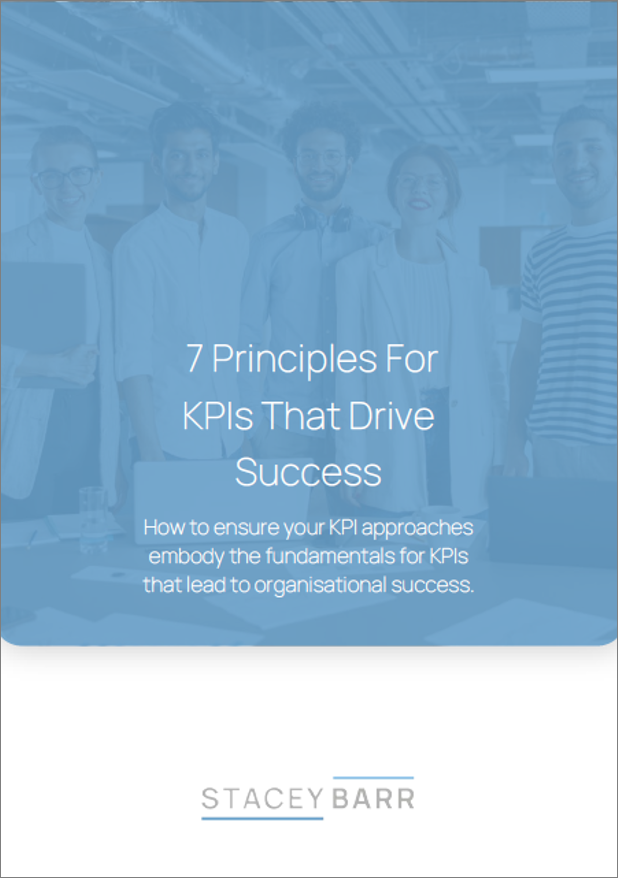7 Principles For KPIs That Drive Success
by Stacey BarrHow to ensure your KPI approaches embody the fundamentals for KPIs that lead to organisational success.

Great KPIs depend on a minimum level of rigour in the thinking that precedes their selection, creation and use.
Great KPIs are great because they keep everyone focused on the results that matter and guide them to take the right actions to achieve those results. This means much more than just hitting targets or holding people accountable. It’s about making real and lasting improvements to organisational performance and success.
Too often, people’s experiences with performance measurement make it feel like a waste of time. Experiences like these:
- KPIs don’t feel helpful in solving the biggest challenges keeping them awake at night.
- Budgets are spent and targets are hit, with little evidence that performance is better.
- Team KPIs keep the focus inside their organisational silos, not collaborating to reach whole-of-organisation goals.
- More time is spent debating KPI integrity than using them to improve performance.
The approaches we take to select, create and use KPIs have a huge bearing on their calibre, on their ability to make a difference that’s worth the time and effort. And for any approach to produce high-calibre KPIs, it needs a set of fundamental principles that guide the thinking behind their selection, creation and use.
Which Principles Are Missing From Your KPI Approaches?
There are seven principles of performance measurement that lead to greater organisational success when they are embodied in the organisation’s KPI approaches. What follows is a summary of each of them, and for more detail you can download the white paper at the end of this article.
Principle 1: Clear Purpose
Great KPIs are focused more on continually improving the results that matter most, than on hitting targets.
Hitting targets is too often done the wrong way, causing unintended consequences. Like setting targets low enough to be achieved easily, and consequently allowing actual performance to erode over time. Or choosing KPIs that only track effort and activity, so performance looks good even if everyone is busy doing things that don’t create value.
The principle of a clear purpose means choosing KPIs that put, and keep, attention on the results that matter most. A clear purpose is essentially the same as having observable results-oriented goals that set the context for choosing KPIs and actions that truly improve overall performance.
TIP: Write goals that describe observable results, so they are more measurable and more easily understood and owned.
WATCH MORE: A Recipe To Write A Measurable Goal
Principle 2: Systems Thinking
Great KPIs are integrated into a single dynamic story of how the organisation performs, as a whole.
We might hear complaints from the delivery team that their KPI is falling short because of the actions of the supply team. Or we celebrate a reduction in our expenditure KPI, but then find it just goes back up again. Or we see the marketing team kicking all their KPI goals, but no increase in revenue or customer growth. These are signs that the performance of the parts of the organisation isn’t serving the performance of the whole organisation.
Systems thinking means appreciating an organisation as an entity made up of interconnecting and interdependent parts. A cause-effect map, driven by systems thinking, is a great tool for each team to stay oriented to the organisation’s purpose, but also to the collaboration they need with other teams.
TIP: Build a cause-effect Results Map for the whole organisation, so every team can see their impact on achieving its intended purpose, as well as their impact on other teams.
WATCH MORE: Create True Organisational Alignment With a Results Map
Principle 3: Process Alignment
Great KPIs more easily link strategic aims to the right actions when they align with processes, not functions.
When we invest time and resources into change, we want to see improvements that were worth the investment. But how easy is it to jump to obvious solutions, which end up with barely any impact? How often do we find we’re only treating symptoms of performance problems, because the root causes aren’t clear? How hard is it to find performance improvements that don’t require an ongoing investment to maintain the new level of performance?
Processes are the sequential flows of tasks and decisions that produce outputs, like new policies or delivered products or employee skills. Processes are the window through which we can see exactly where performance can be improved, by redesigning or modifying the process in a way that fixes the performance problem, once and for all.
TIP: Next time you need to improve a KPI, identify and flowchart the business process that most affects that KPI, and look for root causes, like this example.
WATCH MORE: Cause-Effect, Not Copy-Paste
Principle 4: Human Centred
Great KPIs drive the right behaviours when accountability focuses on learning and improvement, instead of judgement.
People can have some unintended reactions to KPIs. They may continually argue against every suggested KPI. They may ignore them completely. They may be selective about only reporting the “good news” KPIs. They may report KPIs in a way that distorts the message to make their point. Behaviours like these easily evolve into a culture of avoiding accountability.
Getting people into a more curious and collaborative relationship with KPIs can be as simple as changing the role that KPIs take in employee performance management and team performance meetings. Instead of holding people accountable for what their KPIs are doing, hold them accountable for what they’re doing with their KPIs to improve organisational performance.
TIP: Define the accountability of KPI owners as monitoring the KPI, validly interpreting the KPI, and initiating action to improve the KPI’s performance.
WATCH MORE: What Is A KPI Owner Accountable For?
Principle 5: Numerical Integrity
Great KPIs are based on data and calculations that are trusted by everyone who uses them.
Not every KPI is trusted, and not every KPI is trustworthy. One symptom of this is when more time is spent debating KPI integrity than using them to decide on the best performance improvements. Another symptom is when different reports include the same KPI, but they show conflicting results. And yet another symptom is when people assume a KPI is measuring one thing, but it’s actually measuring something else.
A KPI is trusted when its definition is transparent to everyone, and that definition proves it to be trustworthy. And a KPI is trustworthy when its calculation is appropriate to its purpose and based on reliable data. Each KPI needs a definition that maintains a single version of the truth.
TIP: Create a single repository for all KPI definitions, and make it transparent so everyone can understand any KPI they need.
WATCH MORE: 4-Step Recipe For Writing Quantitative KPIs
Principle 6: Statistical Interpretation
Great KPIs are analysed and presented based on valid statistical rules so they are never misunderstood.
Have you ever reviewed a KPI with a team and struggled to agree on what the KPI was actually telling you? Have you ever been surprised by performance suddenly getting worse (or better) without apparent warning? Or noticed performance getting more chaotic with each attempt to improve it?
We misunderstand our KPIs without basic skills in statistical thinking. Statistical thinking is the ability to discern signals from random noise. Instead of being misled by “% variances” and comparing individual KPI values to each other, we can quickly and easily see the true signals in our KPI values, using XmR charts.
TIP: See this example of how to interpret KPIs more easily with XmR charts. They might seem unusual at first, but their power is quickly appreciated.
WATCH MORE: Why KPI Thresholds Are A Bad Idea
Principle 7: Decision Integration
Great KPIs inform each stage of decision making for performance improvement: before, during and after.
How many KPIs are reported, but rarely help to make a better decision about performance? How often are change initiatives forging ahead with no KPI to evaluate the size of their impact? How much do we really learn from KPIs if they’re only used at the end of the planning cycle to check if goals were achieved, or not?
Integrating KPIs with strategic and operational decision making is about creating a rhythm to frequently evaluate performance using a suite of KPIs that answer these three questions: what is performance doing, why is it doing that, & how should we respond?
TIP: Check your performance dashboards to see if they can answer those three questions: what, why & how?
WATCH MORE: 5 Steps For A Fast Performance Dashboard
Embody The 7 Principles In Your KPI Approaches
If the performance measurement approach we use doesn’t embody these principles, great KPIs will only happen by accident, and most KPIs will be a waste of time and effort.
Do you know what principles are at the heart of Balanced Scorecard, or OKRs, or whichever framework you’re using as a KPI approach?
PuMP is a complete KPI methodology that was deliberately built upon these seven principles. All of PuMP’s steps and techniques have the practical instructions to turn these principles into action.
Other KPI approaches can be modified to do the same, but why reinvent thinking that’s already been done? Adopting PuMP is the fastest way to transform your measurement approach to produce KPIs that lead to greater organisational success. The thinking has already been done, and proven over decades.
Download The White Paper…
Download the full White Paper “7 Principles For KPIs That Drive Success” for more detail and practical tips to embody these principles into your KPI approaches.
Connect with Stacey
Haven’t found what you’re looking for? Want more information? Fill out the form below and I’ll get in touch with you as soon as possible.
167 Eagle Street,
Brisbane Qld 4000,
Australia
ACN: 129953635
Director: Stacey Barr





